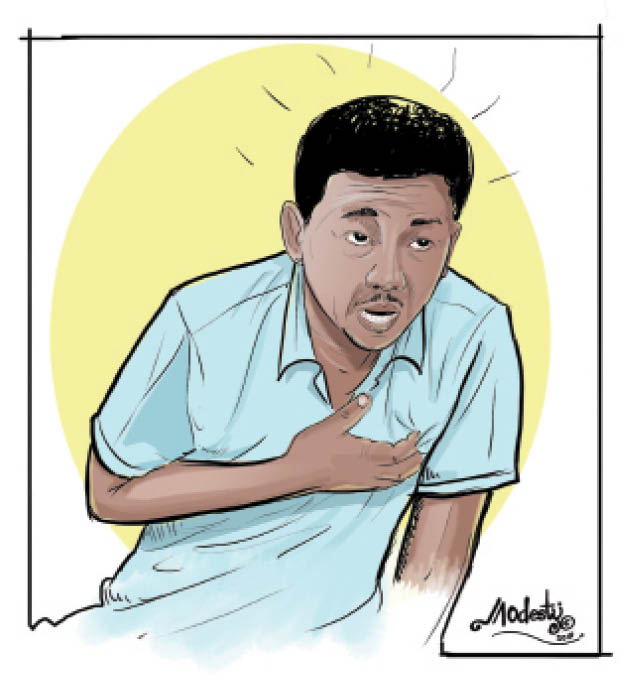Signs of panic disorder
Twenty five-year-old Salome (not real name) said she went through ugly experiences some years back that made her to have sudden intense fear. She experienced out of the blue panic attacks repeatedly after that and soon began to worry about witnessing situations that would cause her such panic again. She complained of shortness of breath, […]

Twenty five-year-old Salome (not real name) said she went through ugly experiences some years back that made her to have sudden intense fear. She experienced out of the blue panic attacks repeatedly after that and soon began to worry about witnessing situations that would cause her such panic again.
She complained of shortness of breath, numbness, tightness in the chest and feeling of fainting. The young graduate said she noticed most of the symptoms while in 300 level at the university two years back.
“Although I had many of such experiences, I never realised what they meant until when I came home on holiday and visited a doctor who examined me and referred me to a psychologist. I was diagnosed with panic disorder after that,” she said.
Panic disorder is one of the types of anxiety disorder which comes with recurrent unexpected panic attacks. Other types are agoraphobia, social phobia (social anxiety disorder), Obsessive-Compulsive Disorder (OCD), Post-Traumatic Stress Disorder (PTSD), Generalised Anxiety Disorder (GAD), Acute Stress Disorder (ASD) and Substance Induced Anxiety Disorder (SIAD).
People with panic disorder often worry about when the next attack will happen and actively try to prevent future attacks by avoiding places, situations or behaviour they associate with panic attacks.
Worry about panic attacks and the effort spent trying to avoid them cause significant problems in various areas of a person’s life, including the development of agoraphobia. An anxiety disorder is characterised by intense fear or anxiety about being in open or public places or a symptom of anxiety in situations where the person perceives their environment to be unsafe.
A Psychologist and Mental Health Advisor at Baze University Abuja, Dr. Oladele Fagbohun, said for people to be diagnosed with panic disorder, “There must be experience of frequent and unexpected panic attacks within four weeks with continuous worry about the attacks. There is also a consequence whereby the person thinks the attack has to do with the functioning of the heart; but having one or two panic attacks does not go into the definition of panic disorder.”
Dr. Fagbohun said the symptoms included but were not limited to the following: Complaint of palpitations (unnecessary beating of the heart or pounding), sweating, trembling and shaking.
Other signs are shortness of breath or difficulty in breathing, difficulty in swallowing, chest pain or the feeling of tightness in the chest area, nausea and abdominal discomfort and dizziness.
He added that there were reports of patients losing control or going crazy and having fear of dying.
“Patients also complain of some funny sensations or numbness; there are chills or hot flashes which are the things somebody undergoing a panic attack can have, but it is not necessary for all to appear in a single person at a time. Generally, at least four of the symptoms would be present,” he said.
According to the mental health expert, panic disorder is a mental health issue that causes distress to the individual when having some of the listed symptoms frequently and does not allow the individual to perform his or her daily functions properly. The situation also affects interpersonal relationships thereby requiring immediate intervention from a psychiatrist or psychotherapist.
“People suffering from panic disorder are normal people, but at that point when the attack comes, they begin to misbehave and it’s only the individual that is affected and not the public around them. And some who suffer from such attacks may not know the diagnosis involved until they book appointment with a general medical practitioner who after cross examination may refer such to the psychotherapist or psychiatrist.
So, it is the duty of the doctor to ask questions and take history of the person on how the symptoms come.
“The doctor will also ask direct questions of the intake of some drugs. Some substances that can induce panic attacks are caffeine, cocaine and withdrawal of sedatives. Some stimulants also can fairly cause panic attacks, others are drugs that are used to treat anxiety and some other illnesses; meaning when a patient stops using prescribed drugs without supervision, it could lead to panic disorder,” he further explained.
He said some medical conditions that induced panic disorder were hyper-pyroidsm, hypoglycemian (low glucose level in the blood) and phaeochromo-cytoma.
“When the doctor has listened to the patient and listed all the symptoms, he would still need to carry out investigation to be sure that it is not any of the medical conditions or drug abuse that resulted in the panic attacks. When none of these are positive, then the doctor can now carry out panic disorder diagnosis and refer to the appropriate clinician,” he said.
Dr. Fagbohun said, “It is best managed by a psychiatrist and a psychotherapist. There are two ways of treatment applicable: with drugs or psychotherapy or the combination of the two. But we usually have psychotherapy sessions with the psychotherapist.”
He advised that people must first understand that people who had panic disorder or people who went to see a psychiatrist were not “mad” as said in a lay man’s language.
“This thought amounts to stigmatisation; and that is the main problem. This is a medical aspect that treats other conditions that are not psychotic and it is wrong to stigmatise anyone that visits a psychiatrist as “mad”. Let people have this orientation and understand that visiting a psychiatrist is as normal as visiting a gynaecologist, cardiologist, neurologist and others,” he advised.
He added that when such symptoms persisted in this particular situation, it was impossible not to seek intervention because it was disturbing and could lead to thoughts of suicide.
